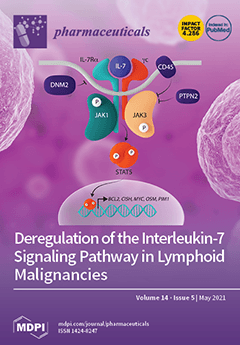The purpose of this study was to evaluate the ocular pharmacokinetics, bio-distribution and local tolerability of γ-cyclodextrin (γCD) based irbesartan 1.5% eye drops and candesartan 0.15% eye drops after single and multiple topical administration in rabbit eyes. In this randomized, controlled study, a total number of 59 New Zealand White albino rabbits were consecutively assigned to two study groups. Group 1 (
n = 31) received irbesartan 1.5% and group 2 (
n = 28) candesartan 0.15% eye drops. In both groups, single dose and multiple administration pharmacokinetic studies were performed. Rabbits were euthanized at five predefined time points after single-dose administration, whereas multiple-dose animals were dosed for 5 days twice-daily and then euthanized 1 h after the last dose administration. Drug concentration was measured by using liquid chromatography-tandem mass spectrometry (LC-MS/MS) in the retinal tissue, vitreous humor, aqueous humor, corneal tissue and in venous blood samples. Pharmacokinetic parameters including maximal drug concentration (C
max), time of maximal drug concentration (T
max), half-life and AUC were calculated. To assess local tolerability, six additional rabbits received 1.5% irbesartan eye drops twice daily in one eye for 28 days. Tolerability was assessed using a modified Draize test and corneal sensibility by Cochet Bonnet esthesiometry. Both γCD based eye drops were rapidly absorbed and distributed in the anterior and posterior ocular tissues. Within 0.5 h after single administration, the C
max of irbesartan and candesartan in retinal tissue was 251 ± 142 ng/g and 63 ± 39 ng/g, respectively. In the vitreous humor, a C
max of 14 ± 16 ng/g for irbesartan was reached 0.5 h after instillation while C
max was below 2 ng/g for candesartan. For multiple dosing, the observed C
mean in retinal tissue was 338 ± 124 ng/g for irbesartan and 36 ± 10 ng/g for candesartan, whereas mean vitreous humor concentrations were 13 ± 5 ng/g and <2 ng/g, respectively. The highest plasma concentrations of both irbesartan (C
max 5.64 ± 4.08 ng/mL) and candesartan (C
max 4.32 ± 1.04 ng/mL) were reached 0.5 h (T
max) after single administration. Local tolerability was favorable with no remarkable differences between the treated and the control eyes. These results indicate that irbesartan and candesartan in γCD based nanoparticle eye drops can be delivered to the retinal tissue of the rabbit’s eye in pharmacologically relevant concentrations. Moreover, safety and tolerability profiles appear to be favorable in the rabbit animal model.
Full article






